Pike flyfishing by Barry Reynolds
After have
been reading a book called « pike on the fly » by Barry Reynolds,
I’ve got the idea to share with you barry’s experiment. Barry also wrote
“mastering pike on the fly”.
I haven’t read it yet but I promised you to
summarize it soon.
After pike
on the fly by Jacky Roehrig this is how Barry Reynolds see pike fly fishing.
1 O_LIVE : Hi, Mr Barry
Reynolds. Could you please introduce yourself to the gobages.com community (A French web site in
favour of flyfishing and catch and release)
My name is Barry Reynolds I am 45 years old and
reside in Aurora Colorado USA where I live with my wife Susan. I have guided in
Colorado for over 15 years where I specialize in lake fly fishing for Pike,
Carp, Bass and other assorted warm water game fish.
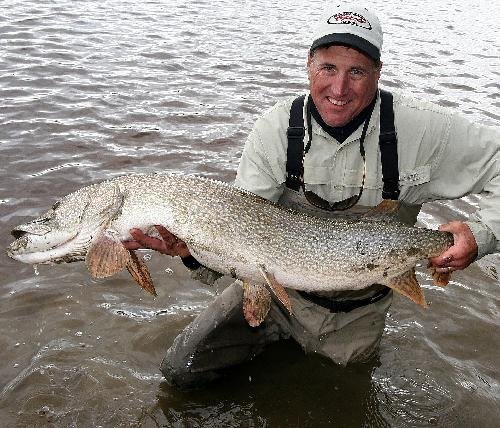
I am a certified fly
casting instructor, serve on the Pro-Staff for companies such as Scott Fly
Rods, Ross Reels, Rio Fly Lines, Smith-Action Optics, I am also a fly designer
for Umpqua Feather Merchants. I have written four books, Pike on the Fly,
Beyond Trout, Carp on the Fly, and most recently Mastering Pike on the Fly! I
am currently working on my fifth book titled Fly Fishing with Barry Reynolds
due to release next fall. I have also appeared in numerous magazine articles
and authored many as well. I have been featured or appeared in Fly Rod & Reel,
American Angler, Southwest Fly Fishing and Warm Water Angler. Last but not
least I have produced two video/DVD’s including the Fly Rodders Guide to Pike,
The Fly Rodders Guide to Carp and just recently completed a full length movie
called Pike on the Fly “In Pursuit of the Water Wolf” that follows my life long
passion of chasing pike on the fly and the search for the “holy grail” of pike
fishing, a 50 inch pike on the fly!
O_live :Bonus N°1: an extract of video "In Poursuit Of the Water Wolf" :
In Pursuit of the Water Wolf
envoyé par O_live
2 O_LIVE : Can you explain
how you come to fish pike on a fly and wrote two books about pike. Is there
some differences between your first and the second book?
First and
foremost I love fly-fishing no matter what the species is. Over the years I
have developed a deep admiration and passion for Northern Pike. My first
experience with pike fishing goes back to 1978 where I was sitting at home
reading an issue of Field and Stream. There was an article on Northern Pike and
I immediately became interested in learning more about pike, how to catch them,
and more importantly where I could find them in a state that was known more for
its Trout fishing. I made several phone calls to the local fish and wildlife
office and found out that indeed Colorado did have Pike in several lakes and
good populations of sizeable fish that were virtually un-touched! After arming
myself with as much information as I could about pike (which was very little at
the time) I set out to catch my first pike, first with artificial lures and
then hopefully with a fly! My first outing was quite successful and I caught a
total of 7 fish including two fish the weighed 25lbs each! I was hooked and the
rest as they say is history!
I continued over the next several years to fish
mostly with artificial lures for pike and learn as much about their behaviour,
feeding patterns, seasonal movements as I could. By my third season of chasing
pike I made the switch to fly tackle.
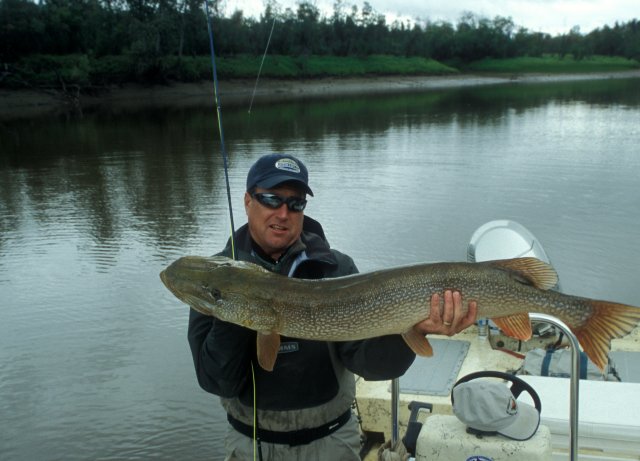
I found that fly fishing for pike was not
only a lot of fun but it was also, at times, a mush more effective way of
taking pike on artificals. By 1990 I had taken literally thousands of pike on
the fly but was still disgusted by the fact that there was no books available
on the subject! After doing numerous seminars both locally and around the
country I was asked why I had not written a book on the subject yet. I began to
ponder the idea of writing my first book, I had all the notes I had collected
each time I went pike fishing so I figured why not? That was when the first
book Pike on the Fly was written! This book was merely a introduction to pike
on the fly and was by no means a complete text. Pike on the Fly was a way to
help anglers get their feet wet and a starting place for those you wished to
pursue pike in the fly. Ten years later after more and more anglers began to
pursue pike I felt like it was time to go into great depth and detail about
pike fly fishing! Mastering Pike on the Fly covers everything that Pike on the
Fly did but in more detail and depth. I like to explain it this way; it is
impossible to teach people all the tiny details and specifics until they have
experienced themselves first hand first. So with the first book we gave them
the “general” information they needed to get started and be successful with
thought bogging them down with to many details. Then in Mastering Pike on the
Fly I decided it was time to give them more intimate details and more specifics
about how to present the fly in a variety of different situations on different
types of waters. Mastering Pike on the Fly is a ten-year refinement of Pike on
the Fly!
3 O_LIVE : At the moment,
What do you think about pike fly fishing. Is it a marginal way of
fishing ?
Ten years ago I might have agreed with that
statement! In the early years I focused on the shallow water period right after
the spawn where large numbers of fish would gather to feed before high summer
water temperatures forced them back out into deeper water and the pike
scattered! However, over the last 10 years or so as more and more people
started fishing during this prime time I found myself fighting other anglers
for prime locations. It was then that I discovered pike could still be caught
in good numbers and size throughout the rest of the season.
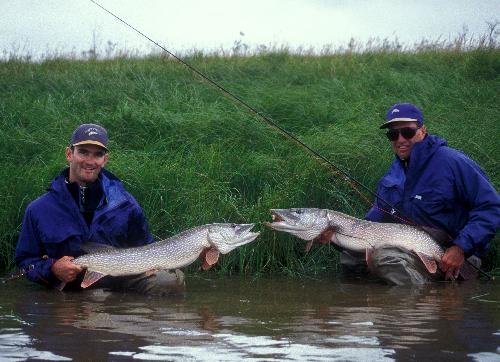
I began to focus on
the fall season and discovered unbelievable action on big, big fish! I now like
to target and fish pike in the spring and fall but the fall months have quickly
become my favourite as it is big pike time. The numbers go down but the average
size goes way up. Pike will typically put on 25% more body weight as they head
into the winter months as they begin to fatten up for both the upcoming winter
and next springs spawn! I have now taken 31 pike over the 50 inch mark
including my personal best of 54 inches and all but three of them where caught
during the fall months!
4 O_LIVE : In your book
« pike on a fly » you speak about three kinds of pikes : Esox,
Musky and Tiger. Could you describe their behaviour? Is there some
specificities for fishing this different pikes?
If I made a
mistake in the book Pike on the Fly it was trying to include all three of those
species of Esox in one book! They are quite uniquely different, water
temperature preferences, spawn, forage, habitat all very from fish to fish as
well as from lake to lake depending on what’s available! So I will give you a
very brief description of these fish. The Muskie, spawns about a month later
than pike do, they do not populate a lake the way pike do, lower numbers of
muskie typically equates to less competition making the Muskie tougher to
catch. Muskies outgrow their cousin pike, a 50 inch muskie is much more common
than say a 50 inch pike. As a result Muskie are held much higher in the
“trophy” status because they are tougher to catch and as I said can grow to
much larger top end sizes!

Pike on the other hand typically spawn before the
Muskie do and as a result once the pike fry hatch and begin to feed on other
fish is usually about the same time the Muskie fry hatch making them perfect
food for the young pike! Pike also will typically populate a given body of more
densely making them much more competive and thus usually easier to catch.
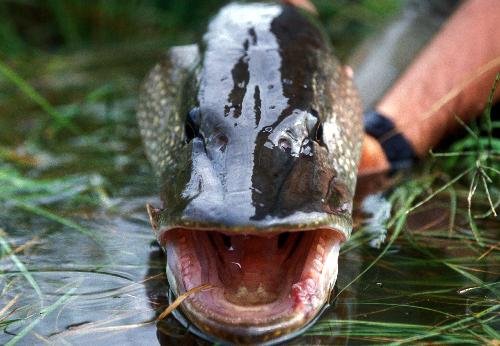
Tiger
Muskie is the result of one of two factors, first, they do occur naturally in
place where there are both pike and muskie present and the odd times where
their spawns actually overlap you will get some natural cross-breeding! More
times than not though Tiger Muskie occur because of direct involvement with
man. In fish hatcheries biologist raise these fish on purpose and stock them
into given bodies of water where a top end predator is needed both for sport
and also to keep rough fish in check.
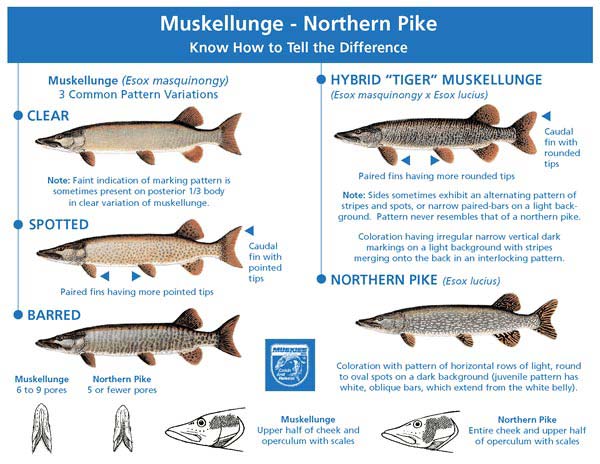
The bonus to Tiger Muskies is the grow
rather quickly and within ten years can exceed 50 inches and forty pounds! The
down size is their quick growth normally means a short life span. In the case
of tiger muskie here in Colorado the expected life span is between 10 and 12
years while true pike and muskies may live as long as thirty years!
5 O_LIVE : What is the best
season ? Could you describe the fish behaviour? What are the best hours to
catch them according to the tree species Again we will just talk about pike due
to how long this can get!
My
favourite time of year for is a tough question! If I want to sight fish for
pike it would definetly be the spring after the spawn! Big numbers of fish
gather in small shallow water areas to feed heavily after the spawn. This a
awesome time to sight cast to big fish, I really enjoy watching big pike hone
in on the fly and chase it down from a long distance! Nothing gets the blood
flowing and the heart pumping better than seeing this in gin clear water!
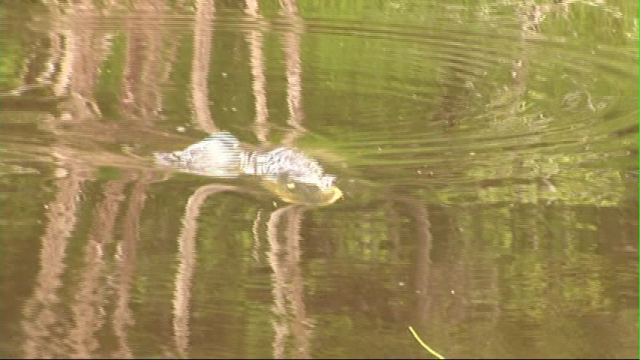
On
the flip side is if I am targeting really big pike I would want to fish the
fall months as the waters begin to cool back down prior to the lakes freezing
for the winter. Fall is big pike time and while the numbers aren’t as high and
the fish are more scattered the payoff comes in the form of giant fish. Keep in
mind that fall pike are fattening up for the winter months and next springs
spawn and as a result fall pike can weigh as much as 25% more than the same
fish you caught in the spring. To me you can not go wrong either way it just
depends what you are looking for in return!
6 O_LIVE : What are your favourite destinations around
the world? Any hot rivers or lakes to recommend?
My to favourite pike destinations are :
Midnight
Sun Trophy Pike Adventures who operate out of the Innoko River in Alaska
and
Wollaston Lake Lodge on Wollaston Lake in Northern Saskatchewan Canada!
Both of
these fisheries produce tremendous numbers of big fish! The Innoko River
produces more 50 inch class pike than any other water that I know of and have
seen pike that are pushing the 60 inch mark in these waters. Wollaston is a gin
clear lake that offers tremendous sight fishing and the chance of 50 inch class
fish as well!
7 O_LIVE : When you fish a lake what is your strategy
according to the tree species. And in the river?
My pike stratagies change according to time of
year, weather conditions, available forage, and habitat! In the spring time I
like to fish later in the afternoon as water temperatures begin to warm up the
pike begin to move into the shallows. Morning might find these areas void of
fish, while the afternoon sunshine and warmth can load these areas up!

The best
advice here is consistency is your best friend. Pike like most other fish don’t
react well to dramatic changes, water temperatures, water levels can and will
all effect how fish behave and locate! I don’t care if it is cold and rainy or
sunny and warm just as long as the weather doesn’t make dramatic changes the
fishing should be good. While fishing in rivers I look for the same thing I do
in lakes, structure, cover, water temperatures, forage, one thing to keep in
mind and avoid is faster or strong moving currents as pike will avoid these
areas when possible. During the spring time I look for pike in the flooded
grass areas or any muddy flats that are available and can be used as spawning
grounds. During the summer months pike in rivers will transition towards
islands and channels where deeper water is easy to access. Once again in the
fall I seek out shallow water structure and cover, sloughs, islands, isolated
weed beds and rock piles are good places to start.
8 O_LIVE : You just met a beginner …any advises for
him ?
I think
pike are an excellent choice for anglers just starting out. Pike, in particular
small pike, are easy to catch, easy to approach, and can be quite rewarding!
Here again I think the best approach is understand the fish that you pursuing
as much as possible before starting out. Once you have some basic knowledge
about the pike, its seasonal movements, habitat and structure preferences, and
what they like to eat pike can be quite easy to catch. Finally once you have
the basic knowledge nothing can beat or replace time on the water! There is a
learning curve we all go through no matter what we think we already know. I
still go out each and everyday fully expecting to learn something new.

9 O_LIVE : What is a good equipment to catch a pike on a
fly ? (in particularly action of the rod fast /medium fast/ medium) ?
For pike fishing I prefer a fast or medium fast
action rod. Most of the fly’s I throw are large and some can become quite heavy
once wet. A medium action rod really doesn’t handle the extra water weight
well. Faster action/stiff saltwater rods double very nicely for pike rods. 8,
9, or 10 weight rods are the preference! Again its not that you cant catch a
big pike on a lighter rod but do you really want to stand there all day long
and struggle to cast those big bugs with a rod that is meant to throw trout
flys?
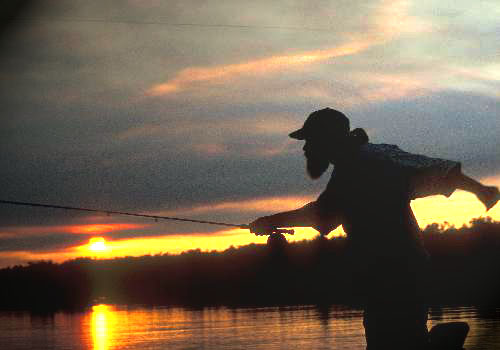
10 O_LIVE : What is the best retrieve according to
the season and the different species Esox, Musky and Tiger ?
The
retrieves work for any of these species, I typically start out with a steady
slow retrieve of 8 to ten inch strips and gradually speed up my retrieve until
I find out what speed they are reacting best to! Some days they may like eratic
retrieves while other days might produce better with a faster more consistent
retrieve. Never get locked into one way of doing things I always like to
experiment with my retireves until I find out exactly what the fish want at
that given moment.
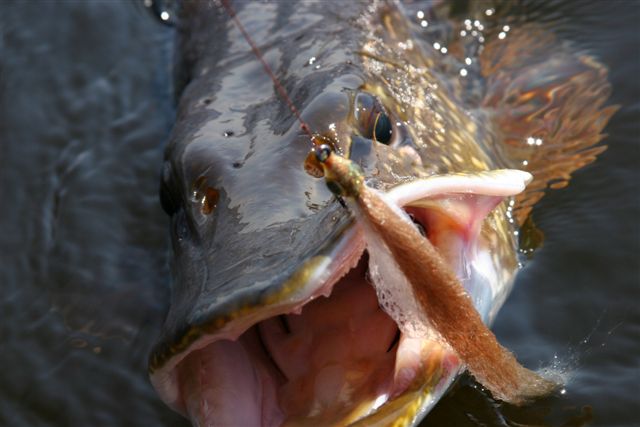
11 O_LIVE : Speaking about
strategy…floating line or sinking line ? Can you tell us more ?
Both! I
always carry a spare spool with the other line on it! Floating line work best
in the spring time when pike are shallow and my use of sink tip lines comes
into play during the summer moths when pike relocate to deeper water! AS fall
approaches and the pike migrate back towards shallow water a floating line can
be effective again. Other things to consider with your line choices include
weather, in the springtime for example the weather can go from bright, sunny
and hot to cold, rainy and miserable in hours. This will drive the pike from
shallow water to deeper water forcing us to change to a sinking type line to
reach the fish.
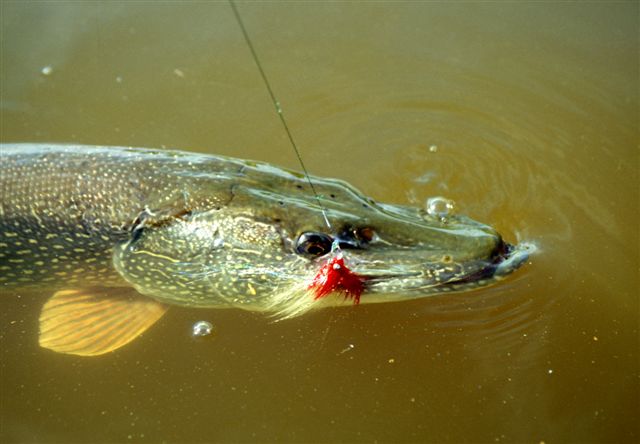
You will also want to consider what presentation and fly you
are offering. One of my favourite tricks is to fish a clipped deer hair diving
fly on a sink tip line and fish a column of water as opposed to just fishing a
level layer of water. This can be deadly effective on suspended pike that are
hanging out on weed beds or other submerged structure.
12 O_LIVE : For you where are
the hot spots in a river and in lake with the best chance to catch a
trophy ?
Tough questions because there are so many variables that come into play.
Pike structure and cover is usually pretty easy to locate so to pick a trophy spot I think you need to first
consider the time of year. For me the best time of year to take a trophy is the
fall.
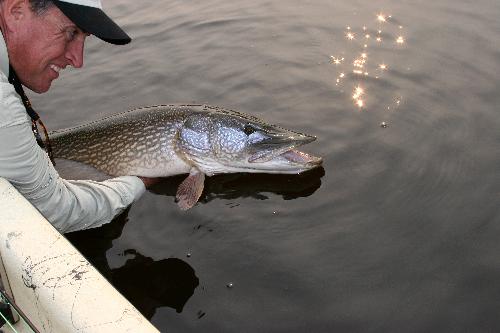
During the fall months on lakes I like to fish the old weed beds that are
starting to die off. If you can find old weed beds with some scattered
rocks/boulders in water that is 6 to 10 feet in depth chances are you are going
to find some big pike hanging nearby. In a river, if I can find a slough or
connecting lake I would start by fishing the points leading in and out of these
areas. If you cant find these areas focus on main points or secondary points
below islands that have “flats” on them and deep water nearby. These areas will
also hold big pike! Remember in pike society there is pecking order and the
biggest pike will take up and hold on the prime areas. If you
think you found a good area for big fish but you are only catching small ones
chances are there is a better spot nearby.
13 O_LIVE : Sometimes we can miss a pike at the first
attack . In this case what is your strategy to catch it? Do you change the size of your fly? Try
another colour? And in the case the pike follow the fly to your feet without
attack it….is there a trick ?
Usually I will try and throw the same fly back
in the direction the fish was last seen. Most times the pike has moved very far
and if it wanted it the first time you can usually get them to attack it again.

In the case of a follow and then a refusal I might change fly’s or try a
different retrieve and change speeds. Remember there is a lot of factors to
consider, is it early in the day and the water temps are still a little cool or
did the fish just miss it completely and would eat it if you can get it in
front of it again!
14 O_LIVE : According to the weather, the different
species, water’s colour …is there any specific colours for the flies
I tend to select my fly colors based on water
clarity first! In clear water I prefer basic black or white if the water I am
fishing is off colored or dirty then I like yellow, chartreuse, yellow/red or
red/white combinations!

Flash is also dictated by water clarity. I always use
flash but the amount is decided by water clarity. Clear water very little
flash, dirty water lots of flash.
15 O_LIVE : For a big pike some people use big bait. So can we says large flie for a huge spike
?Do you change the size of your flies according to the different species or the
fishing season?
Pike fishing on the fly gives new meaning to
match the hatch. As a rule of thumb I fish slightly smaller flies in the spring
and break out the big ones during the fall! Most of my pike flies fall between
5 inches and 7 inches in the spring and grow to 6 inches to a s big as 10
inches during the fall!
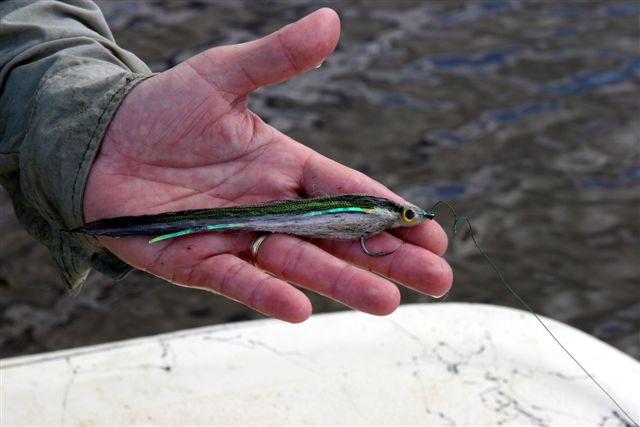
Also keep in mind that size is also dictated by forage
availability as well! Once again no magic answer here but observation on the
water will steer you in the right selection.
16 O_LIVE : Now speaking about
fly tying. What are good specifications for a good flie? What are your
favourite materials for tying? Have you got a pattern for us?
I love rabbit for my pike flies. It is awful
to cast but the movement in the water cant be beat! If I had to choose two
patterns it would be the Gen X Bunny or a Flashtail Whistler!
The Gen X is my
latest bunny style fly which includes a 6 inch rabbit strip tail layed over
krystal flash and Flashabou. The collar is several large webby schlappen
feathers and an epoxy head.
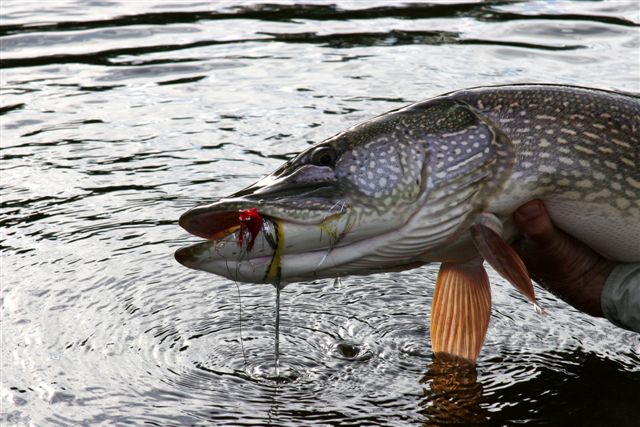
These things are bullet proof against the pikes
sharp teeth and the rabbit undulates through water enticing violent takes.
ps: you can see this fly pattern :Mirror Image Clouser 
17 O_LIVE : What is your opinion about
fluorocarbone ? Do you use it ? do you think it coul be useful when you
fish in clear and low water ?
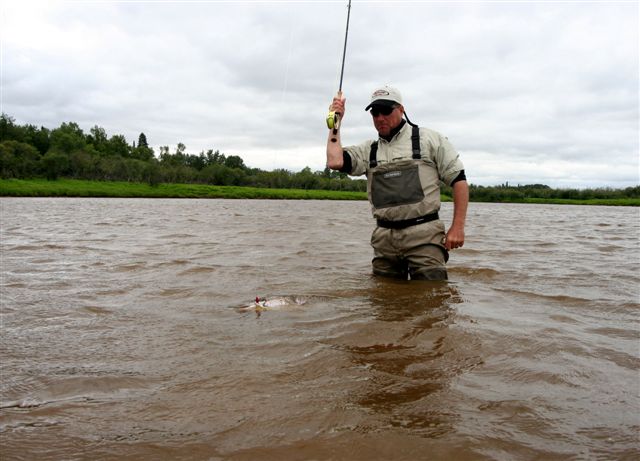
I do not
use fluorocarbon for pike! Instead I prefer 25 pound hard mono attached with an
Albright knot to 16 inches of 20 to 30 pound nylon coated steel.
18 O_LIVE : What is the best way to release a pike
without injure it? Do you smash your barbs? What do you think about use a
“grip” for catch a trophy?
With pike I
always fish barbless, when they take the fly there is usually no giving it
back! I don’t think I have ever lost a fish because I was fishing a barbless
hook and it makes unhooking and releasing the fish much easier and safer! I do
not use a grip either!
I feel grips can be quite harmful as pike roll many
times during handling and the result of this combined with the use of a grip
can break the fish jaw.

Ig you are going to hold the fish make sure you support
the entire length of the body so you are not to damage any of its organs. Most
times it is better to keep the fish in the water the entire time and simply
remove the fly. But like most anglers I want the occasional photo and again I
urge you to support the entire while it is out oof the water.
19 O_LIVE : In
France we only have one specie (essox) but due to pollution, over fishing,
braking of the rules and poaching we have very few trophies compared to your
country. If you were the French minister in charge of environment what kinds of
decisions will you take to protect this fish? Are you in
favour of catch and release?
Water quality would have to be the first issue
and some restrictions would have to be adopted to clean up the waters. Secondly
special regulations would need to be put in place to protect the pike during
the spawn! Without knowing all the specifics this is my best answer.
I do not keep any fish unless they are gilled
hooked and unable to save! I strongly believe in catch and release but in the
case of pike in waters where they thrive selective harvest, keeping some of the
smaller fish would not be a bad idea to prevent over population!
20 O_LIVE: Bonus 2 Video : "Barry Flyfishing Journal" :
Thank you for sharing with us your experiment and your ideas.
May be I’llse you on the internet web site :www.gobages.com or for a fishing party together on the other side of the atlantic ocean ?
And for you my dear “gobnautes” I hope you enjoyed this interview.
It’s my way to promote pike fly fishing and remenber don’t forget to cath and release.
Take your rods and good luck for the next saison.
Authors : O_live & Laurent 46
- Source Images & Video ( bonus 1) : http://www.barryreynoldsflyfishing.com/
- Source Images : http://www.musky.ca/
- Source Video & Video ( bonus 2) : http://youtube.com/
- Special thanks to Jean-Yves






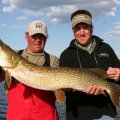






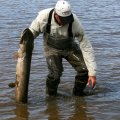
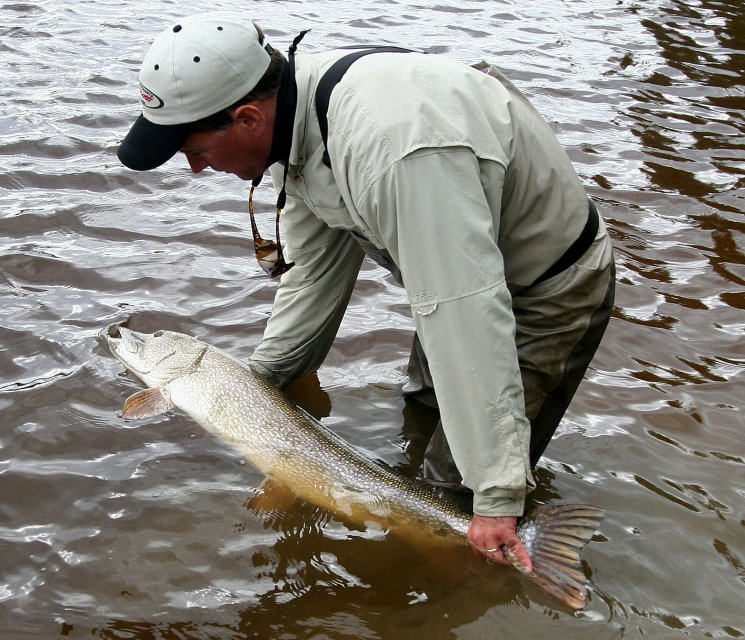
Aucun commentaire.